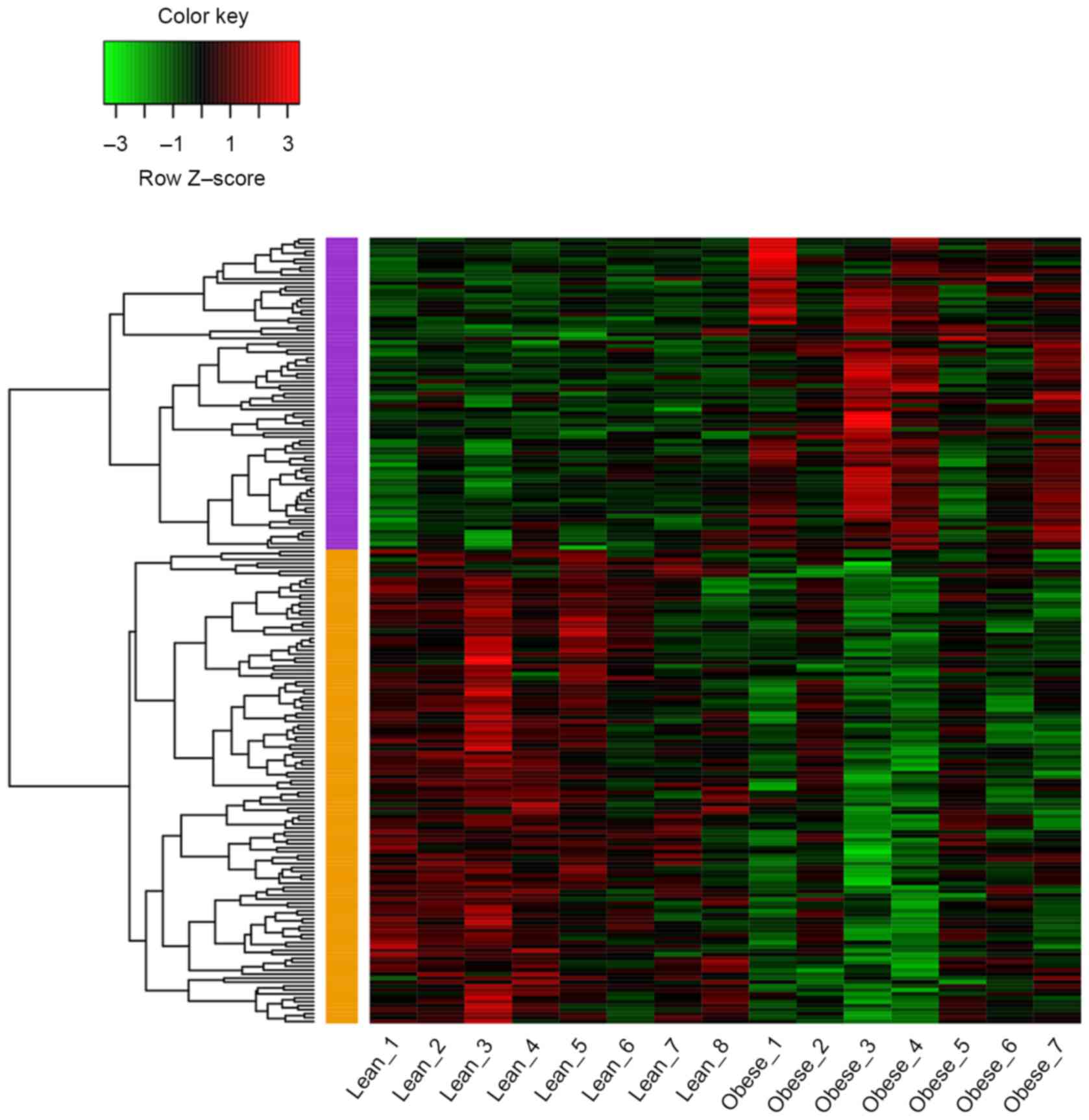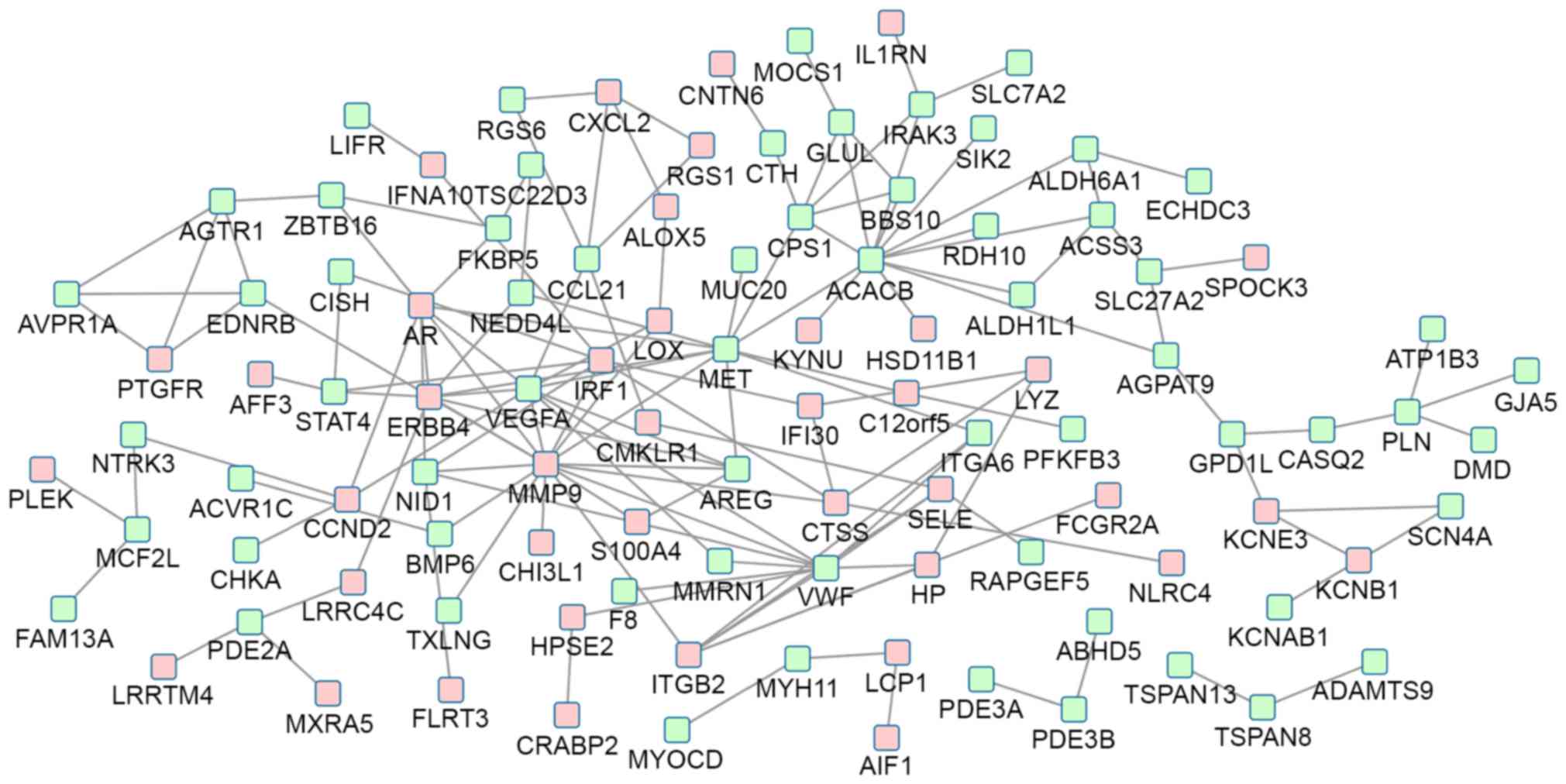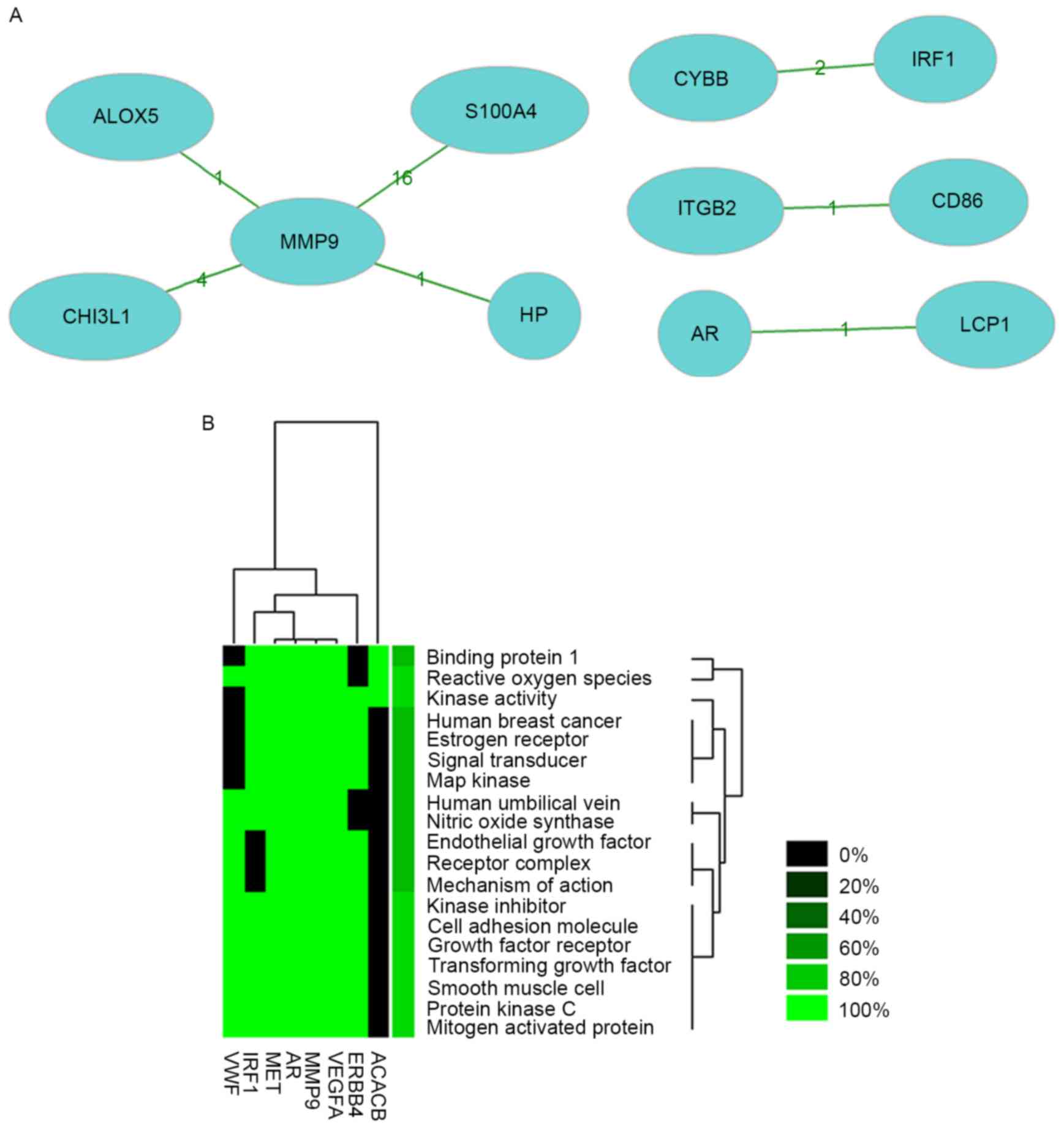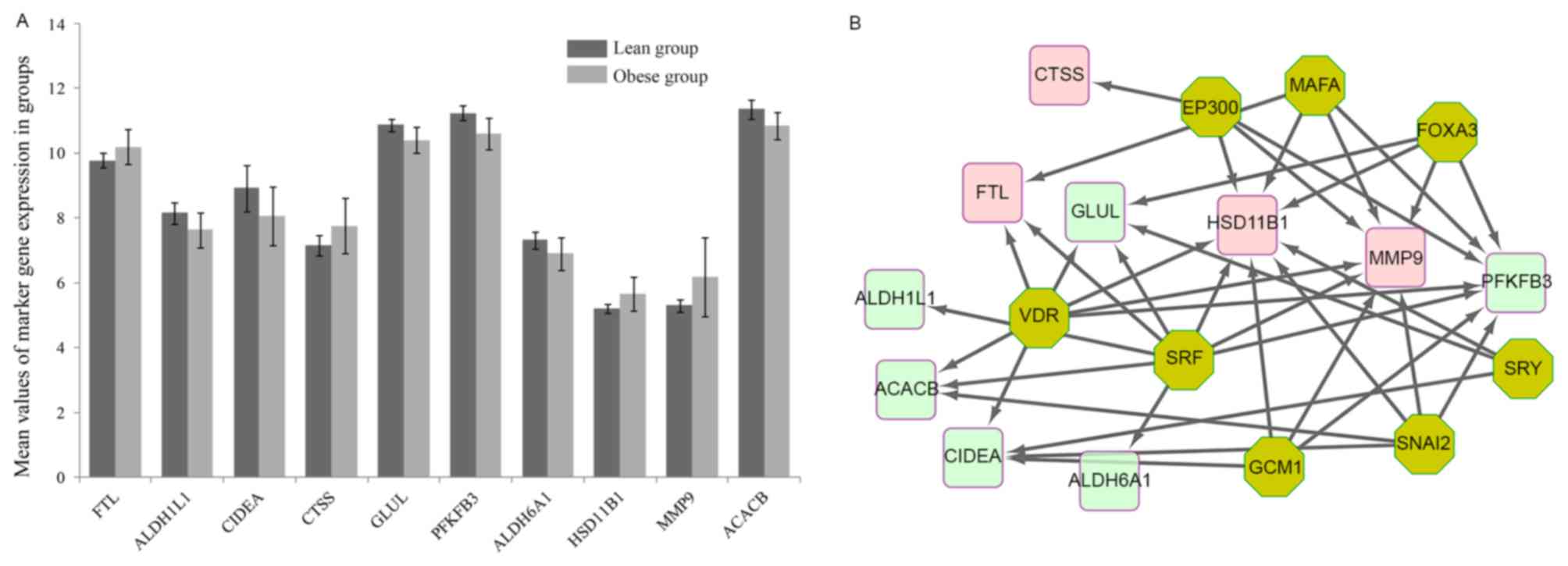|
1
|
Haslam DW and James WP: Obesity. Lancet.
366:1197–1209. 2005. View Article : Google Scholar : PubMed/NCBI
|
|
2
|
Hedley AA, Ogden CL, Johnson CL, Carroll
MD, Curtin LR and Flegal KM: Prevalence of overweight and obesity
among US children, adolescents, and adults, 1999–2002. Jama.
291:2847–2850. 2004. View Article : Google Scholar : PubMed/NCBI
|
|
3
|
Martorell R, Khan L Kettel, Hughes ML and
Grummer-Strawn LM: Overweight and obesity in preschool children
from developing countries. Int J Obes Relat Metab Disord.
24:959–967. 2000. View Article : Google Scholar : PubMed/NCBI
|
|
4
|
National Institutes of Health, . The
practical guide: identification, evaluation and treatment of
overweight and obesity in adults. National Heart, Lung and Blood
Institute; 2002
|
|
5
|
Freedman DS, Khan LK, Dietz WH, Srinivasan
SR and Berenson GS: Relationship of childhood obesity to coronary
heart disease risk factors in adulthood: The Bogalusa heart study.
Pediatrics. 108:712–718. 2001. View Article : Google Scholar : PubMed/NCBI
|
|
6
|
Wajchenberg BL: Subcutaneous and visceral
adipose tissue: Their relation to the metabolic syndrome. Endocr
Rev. 21:697–738. 2000. View Article : Google Scholar : PubMed/NCBI
|
|
7
|
Drincic AT, Armas LA, Diest EE and Heaney
RP: Volumetric dilution, rather than sequestration best explains
the low vitamin D status of obesity. Obesity (Silver Spring).
20:1444–1448. 2012. View Article : Google Scholar : PubMed/NCBI
|
|
8
|
Kim KA, Gu W, Lee IA, Joh EH and Kim DH:
High fat diet-induced gut microbiota exacerbates inflammation and
obesity in mice via the TLR4 signaling pathway. PLoS One.
7:e477132012. View Article : Google Scholar : PubMed/NCBI
|
|
9
|
Farooqi IS and O'Rahilly S: Mutations in
ligands and receptors of the leptin-melanocortin pathway that lead
to obesity. Nat Clin Pract Endocrinol Metab. 4:569–577. 2008.
View Article : Google Scholar : PubMed/NCBI
|
|
10
|
Vernia S, Cavanagh-Kyros J, Barrett T,
Jung DY, Kim JK and Davis RJ: Diet-induced obesity mediated by the
JNK/DIO2 signal transduction pathway. Genes Dev. 27:2345–2355.
2013. View Article : Google Scholar : PubMed/NCBI
|
|
11
|
Hwang JT, Kim SH, Lee MS, Kim SH, Yang HJ,
Kim MJ, Kim HS, Ha J, Kim MS and Kwon DY: Anti-obesity effects of
ginsenoside Rh2 are associated with the activation of AMPK
signaling pathway in 3T3-L1 adipocyte. Biochem Biophys Res Commun.
364:1002–1008. 2007. View Article : Google Scholar : PubMed/NCBI
|
|
12
|
Vohl MC, Sladek R, Robitaille J, Gurd S,
Marceau P, Richard D, Hudson TJ and Tchernof A: A survey of genes
differentially expressed in subcutaneous and visceral adipose
tissue in men. Obes Res. 12:1217–1222. 2004. View Article : Google Scholar : PubMed/NCBI
|
|
13
|
Linder K, Arner P, Flores-Morales A,
Tollet-Egnell P and Norstedt G: Differentially expressed genes in
visceral or subcutaneous adipose tissue of obese men and women. J
Lipid Res. 45:148–154. 2004. View Article : Google Scholar : PubMed/NCBI
|
|
14
|
Frayling TM, Timpson NJ, Weedon MN,
Zeggini E, Freathy RM, Lindgren CM, Perry JR, Elliott KS, Lango H,
Rayner NW, et al: A common variant in the FTO gene is associated
with body mass index and predisposes to childhood and adult
obesity. Science. 316:889–894. 2007. View Article : Google Scholar : PubMed/NCBI
|
|
15
|
Dina C, Meyre D, Gallina S, Durand E,
Körner A, Jacobson P, Carlsson LM, Kiess W, Vatin V, Lecoeur C, et
al: Variation in FTO contributes to childhood obesity and severe
adult obesity. Nat Genet. 39:724–726. 2007. View Article : Google Scholar : PubMed/NCBI
|
|
16
|
Zhang S, Wang B, Shi J and Li J:
Network-based association study of obesity and type 2 diabetes with
gene expression profiles. Biomed Res Int.
2015:6197302015.PubMed/NCBI
|
|
17
|
Chen Y, Li L and Xu R: Disease comorbidity
network guides the detection of molecular evidence for the link
between colorectal cancer and obesity. AMIA Jt Summits Transl Sci
Proc. 2015:pp. 201–206. 2015; PubMed/NCBI
|
|
18
|
Tam CS, Heilbronn LK, Henegar C, Wong M,
Cowell CT, Cowley MJ, Kaplan W, Clément K and Baur LA: An early
inflammatory gene profile in visceral adipose tissue in children.
Int J Pediatr Obes. 6:e360–e363. 2011. View Article : Google Scholar : PubMed/NCBI
|
|
19
|
Gautier L, Cope L, Bolstad BM and Irizarry
RA: affy-analysis of Affymetrix GeneChip data at the probe level.
Bioinformatics. 20:307–315. 2004. View Article : Google Scholar : PubMed/NCBI
|
|
20
|
Carvalho BS and Irizarry RA: A framework
for oligonucleotide microarray preprocessing. Bioinformatics.
26:2363–2367. 2010. View Article : Google Scholar : PubMed/NCBI
|
|
21
|
Ritchie ME, Phipson B, Wu D, Hu Y, Law CW,
Shi W and Smyth GK: limma powers differential expression analyses
for RNA-sequencing and microarray studies. Nucleic Acids Res.
43:e472015. View Article : Google Scholar : PubMed/NCBI
|
|
22
|
Smyth GK: Linear models and empirical
Bayes methods for assessing differential expression in microarray
experiments. Stat Appl Genet Mol Biol. 3:Article3. 2004. View Article : Google Scholar : PubMed/NCBI
|
|
23
|
Ashburner M, Ball CA, Blake JA, Botstein
D, Butler H, Cherry JM, Davis AP, Dolinski K, Dwight SS, Eppig JT,
et al: Gene Ontology: Tool for the unification of biology. Nat
Genet. 25:25–29. 2000. View
Article : Google Scholar : PubMed/NCBI
|
|
24
|
Kanehisa M and Goto S: KEGG: Kyoto
encyclopedia of genes and genomes. Nucleic Acids Res. 28:27–30.
2000. View Article : Google Scholar : PubMed/NCBI
|
|
25
|
Beloqui A, Guazzaroni ME, Pazos F, Vieites
JM, Godoy M, Golyshina OV, Chernikova TN, Waliczek A, Silva-Rocha
R, Al-Ramahi Y, et al: Reactome array: Forging a link between
metabolome and genome. Science. 326:252–257. 2009. View Article : Google Scholar : PubMed/NCBI
|
|
26
|
Szklarczyk D, Franceschini A, Wyder S,
Forslund K, Heller D, Huerta-Cepas J, Simonovic M, Roth A, Santos
A, Tsafou KP, et al: STRING v10: Protein-protein interaction
networks, integrated over the tree of life. Nucleic Acids Res.
43(Database Issue): D447–D452. 2015. View Article : Google Scholar : PubMed/NCBI
|
|
27
|
Shannon P, Markiel A, Ozier O, Baliga NS,
Wang JT, Ramage D, Amin N, Schwikowski B and Ideker T: Cytoscape: A
software environment for integrated models of biomolecular
interaction networks. Genome Res. 13:2498–2504. 2003. View Article : Google Scholar : PubMed/NCBI
|
|
28
|
Wang JH, Zhao LF, Lin P, Su XR, Chen SJ,
Huang LQ, Wang HF, Zhang H, Hu ZF, Yao KT and Huang ZX: GenCLiP
2.0: A web server for functional clustering of genes and
construction of molecular networks based on free terms.
Bioinformatics. 30:2534–2536. 2014. View Article : Google Scholar : PubMed/NCBI
|
|
29
|
Jensen LJ, Saric J and Bork P: Literature
mining for the biologist: From information retrieval to biological
discovery. Nat Rev Genet. 7:119–129. 2006. View Article : Google Scholar : PubMed/NCBI
|
|
30
|
Davis AP, Grondin CJ, Lennon-Hopkins K,
Saraceni-Richards C, Sciaky D, King BL, Wiegers TC and Mattingly
CJ: The Comparative Toxicogenomics Database's 10th year
anniversary: Update 2015. Nucleic Acids Res. 43(Database Issue):
D914–D920. 2015. View Article : Google Scholar : PubMed/NCBI
|
|
31
|
Janky R, Verfaillie A, Imrichová H, Van de
Sande B, Standaert L, Christiaens V, Hulselmans G, Herten K,
Sanchez M Naval, Potier D, et al: iRegulon: From a gene list to a
gene regulatory network using large motif and track collections.
PLoS Comput Biol. 10:e10037312014. View Article : Google Scholar : PubMed/NCBI
|
|
32
|
Głowińska-Olszewska B and Urban M:
Elevated matrix metalloproteinase 9 and tissue inhibitor of
metalloproteinase 1 in obese children and adolescents. Metabolism.
56:799–805. 2007. View Article : Google Scholar : PubMed/NCBI
|
|
33
|
Florys B, Głowińska B, Urban M and
Peczyńska J: Metalloproteinases MMP-2 and MMP-9 and their
inhibitors TIMP-1 and TIMP-2 levels in children and adolescents
with type 1 diabetes. Endokrynol Diabetol Chor Przemiany Materii
Wieku Rozw. 12:184–189. 2006.(In Polish). PubMed/NCBI
|
|
34
|
Andrade VL, Petruceli E, Belo VA,
Andrade-Fernandes CM, Russi CV Caetano, Bosco AA, Tanus-Santos JE
and Sandrim VC: Evaluation of plasmatic MMP-8, MMP-9, TIMP-1 and
MPO levels in obese and lean women. Clin Biochem. 45:412–415. 2012.
View Article : Google Scholar : PubMed/NCBI
|
|
35
|
Andrade VL, Fernandes KS, Bosco AA,
Tanus-Santos JE and Sandrim VC: Functional polymorphism located in
MMP-9 gene promoter is strongly associated with obesity. DNA Cell
Biol. 31:1054–1057. 2012. View Article : Google Scholar : PubMed/NCBI
|
|
36
|
Abu-Elheiga L, Matzuk MM, Abo-Hashema KA
and Wakil SJ: Continuous fatty acid oxidation and reduced fat
storage in mice lacking acetyl-CoA carboxylase 2. Science.
291:2613–2616. 2001. View Article : Google Scholar : PubMed/NCBI
|
|
37
|
Abu-Elheiga L, Brinkley WR, Zhong L,
Chirala SS, Woldegiorgis G and Wakil SJ: The subcellular
localization of acetyl-CoA carboxylase 2. Proc Natl Acad Sci USA.
97:pp. 1444–1449. 2000; View Article : Google Scholar : PubMed/NCBI
|
|
38
|
Riancho JA, Vázquez L, García-Pérez M,
Sainz J, Olmos JM, Hernández JL, Pérez-López J, Amado JA,
Zarrabeitia MT, Cano A and Rodríguez-Rey JC: Association of ACACB
polymorphisms with obesity and diabetes. Mol Genet Metab.
104:670–676. 2011. View Article : Google Scholar : PubMed/NCBI
|
|
39
|
Ma L, Mondal AK, Murea M, Sharma NK,
Tönjes A, Langberg KA, Das SK, Franks PW, Kovacs P, Antinozzi PA,
et al: The effect of ACACB cis-variants on gene expression and
metabolic traits. PLoS One. 6:e238602011. View Article : Google Scholar : PubMed/NCBI
|
|
40
|
Wang JC, Gray NE, Kuo T and Harris CA:
Regulation of triglyceride metabolism by glucocorticoid receptor.
Cell Biosci. 2:192012. View Article : Google Scholar : PubMed/NCBI
|
|
41
|
Sinha R, Dufour S, Petersen KF, LeBon V,
Enoksson S, Ma YZ, Savoye M, Rothman DL, Shulman GI and Caprio S:
Assessment of skeletal muscle triglyceride content by (1)H nuclear
magnetic resonance spectroscopy in lean and obese adolescents:
Relationships to insulin sensitivity, total body fat, and central
adiposity. Diabetes. 51:1022–1027. 2002. View Article : Google Scholar : PubMed/NCBI
|
|
42
|
Marti A, Marcos A and Martinez JA: Obesity
and immune function relationships. Obes Rev. 2:131–140. 2001.
View Article : Google Scholar : PubMed/NCBI
|
|
43
|
de Heredia FP, Gómez-Martínez S and Marcos
A: Obesity, inflammation and the immune system. Proc Nutr Soc.
71:pp. 332–338. 2012; View Article : Google Scholar : PubMed/NCBI
|
|
44
|
Pietiläinen KH, Róg T, Seppänen-Laakso T,
Virtue S, Gopalacharyulu P, Tang J, Rodriguez-Cuenca S, Maciejewski
A, Naukkarinen J, Ruskeepää AL, et al: Association of lipidome
remodeling in the adipocyte membrane with acquired obesity in
humans. PLoS Biol. 9:e10006232011. View Article : Google Scholar : PubMed/NCBI
|
|
45
|
Patel PS, Buras ED and Balasubramanyam A:
The role of the immune system in obesity and insulin resistance. J
Obes. 2013:6161932013. View Article : Google Scholar : PubMed/NCBI
|
|
46
|
Buckman LB, Hasty AH, Flaherty DK, Buckman
CT, Thompson MM, Matlock BK, Weller K and Ellacott KL: Obesity
induced by a high-fat diet is associated with increased immune cell
entry into the central nervous system. Brain Behav Immun. 35:33–42.
2014. View Article : Google Scholar : PubMed/NCBI
|
|
47
|
Manco M, Fernandez-Real JM, Equitani F,
Vendrell J, Mora ME Valera, Nanni G, Tondolo V, Calvani M, Ricart
W, Castagneto M and Mingrone G: Effect of massive weight loss on
inflammatory adipocytokines and the innate immune system in
morbidly obese women. J Clin Endocrinol Metab. 92:483–490. 2007.
View Article : Google Scholar : PubMed/NCBI
|
|
48
|
Laimer M, Kaser S, Kranebitter M,
Sandhofer A, Mühlmann G, Schwelberger H, Weiss H, Patsch JR and
Ebenbichler CF: Effect of pronounced weight loss on the
nontraditional cardiovascular risk marker matrix
metalloproteinase-9 in middle-aged morbidly obese women. Int J Obes
(Lond). 29:498–501. 2005.PubMed/NCBI
|


















